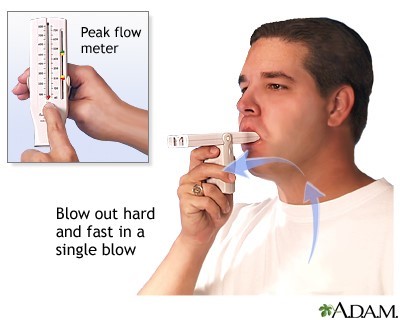A nurse is reinforcing teaching with a client about the use of a peak flow meter.
Which of the following actions should the nurse take first?
Determine the client’s knowledge of the use of the peak flow meter.
Show the client a video demonstration of peak flow meter use.
Observe the client using the peak flow meter.
Emphasize the importance of the daily use of the peak flow meter.
The Correct Answer is A
This is because the nurse should first assess the client’s baseline knowledge and readiness to learn before providing any teaching.
The nurse should also tailor the teaching to the client’s individual needs and preferences.
Choice B is wrong because showing the client a video demonstration of peak flow meter use may not be the most effective way of teaching if the client has different learning styles or needs.
The nurse should also involve the client in the learning process and not just rely on passive methods.
Choice C is wrong because observing the client using the peak flow meter is an evaluation step that should be done after teaching and reinforcing the correct technique.
The nurse should not assume that the client knows how to use the peak flow meter without assessing their knowledge first.
Choice D is wrong because emphasizing the importance of the daily use of the peak flow meter is a motivational strategy that should be done after assessing the client’s knowledge and providing teaching.
The nurse should also explain the rationale and benefits of using the peak flow meter, not just tell the client to do it.
A peak flow meter is a small device that measures how fast a person can forcefully blow air out of their lungs in one fast breath.
It is one indicator of airways changes that may occur in people with asthma or COPD.
To get a peak flow meter, speak to a doctor.

Nursing Test Bank
Naxlex Comprehensive Predictor Exams
Related Questions
Correct Answer is B
Explanation
This action can help to reduce environmental stressors for clients in an acute care unit by limiting noise, crowding, and potential sources of infection.
Visitors should be allowed according to the client’s preference and condition, but excessive or inappropriate visitors should be discouraged.
Choice A is wrong because offering the clients many choices regarding care can increase their stress and anxiety, especially if they are confused, overwhelmed, or unable to make decisions.
The nurse should respect the client’s autonomy and preferences, but also provide guidance and education to help them make informed choices.
Choice C is wrong because assigning different nurses to provide care for clients each day can reduce the continuity and quality of care, as well as the trust and rapport between the client and the nurse.
The nurse should strive to provide consistent and individualized care for each client and establish a therapeutic relationship.
Choice D is wrong because turning on loud music in client care areas can increase environmental stressors for clients in an acute care unit by creating noise pollution, disrupting sleep, and interfering with communication.
The nurse should maintain a quiet and calm environment for the clients and use music only if it is soothing and requested by the client.
Correct Answer is B
Explanation

This type of aphasia is caused by damage to the frontal lobe of the brain, which affects the ability to produce language.
People with expressive aphasia can understand speech and know what they want to say, but they have difficulty saying words or forming sentences.
They may speak in short phrases that require a lot of effort.
Choice A is wrong because receptive aphasia is a type of fluent aphasia that affects the ability to comprehend language.
People with receptive aphasia have difficulty understanding speech and may produce meaningless words or sentences.
Choice C is wrong because global aphasia is the most severe type of aphasia that affects both the production and comprehension of language.
People with global aphasia cannot speak many words and do not understand speech.
They also cannot read or write.
Choice D is wrong because sensory aphasia is not a common term for a type of aphasia.
It may refer to Wernicke’s aphasia, which is another type of fluent aphasia that affects the ability to produce meaningful language.
People with Wernicke’s aphasia can speak fluently but often use incorrect or invented words or phrases.
Whether you are a student looking to ace your exams or a practicing nurse seeking to enhance your expertise , our nursing education contents will empower you with the confidence and competence to make a difference in the lives of patients and become a respected leader in the healthcare field.
Visit Naxlex, invest in your future and unlock endless possibilities with our unparalleled nursing education contents today
Report Wrong Answer on the Current Question
Do you disagree with the answer? If yes, what is your expected answer? Explain.
Kindly be descriptive with the issue you are facing.
